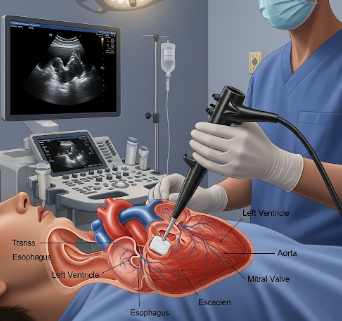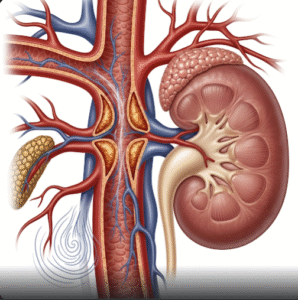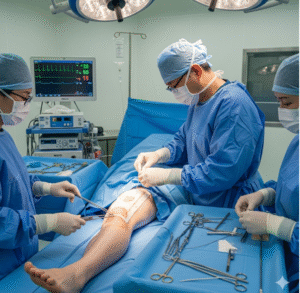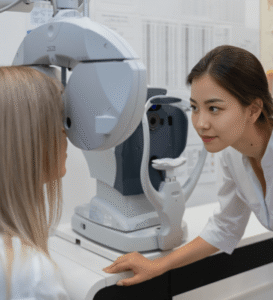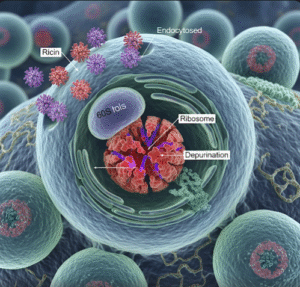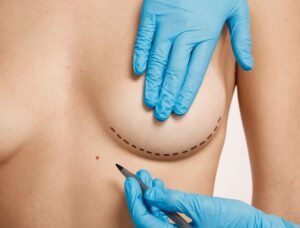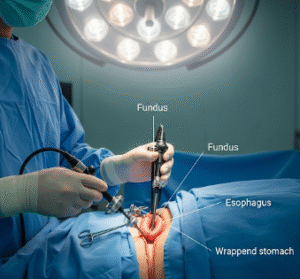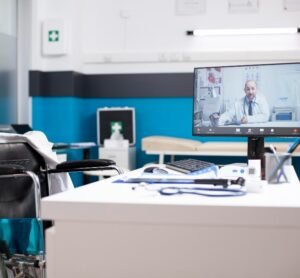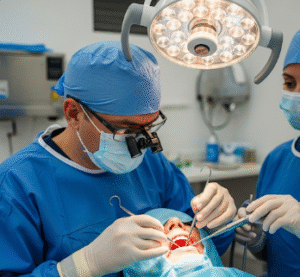Overview
A Trans-Oesophageal Echocardiogram (TOE or TEE) is a diagnostic procedure that uses ultrasound imaging to provide detailed pictures of the heart through the esophagus. This allows closer and clearer visualization of cardiac structures than a standard transthoracic echocardiogram.
In Korea, TOE is performed in advanced cardiology and cardiac imaging centers, providing accurate diagnosis, real-time assessment, and safe, minimally invasive imaging. It is widely used for evaluating heart valves, atrial appendages, congenital defects, and clots.
What is a TOE (Trans-Oesophageal Echocardiogram)?
TOE involves inserting a specialized ultrasound probe into the esophagus, which lies directly behind the heart. This allows high-resolution imaging of cardiac structures, including:
- ✦ Heart valves (mitral, aortic, tricuspid, pulmonary) for stenosis or regurgitation.
- ➤ Atrial chambers, particularly the left atrial appendage, for clots or thrombi.
- ✦ Congenital heart defects such as septal defects or anomalous vessels.
- ➤ Endocarditis or vegetations on heart valves.
TOE provides detailed structural and functional assessment that may not be visible on standard echocardiography.
What are the Benefits?
TOE offers several key benefits:
✅ Highly detailed heart imaging due to proximity of the esophagus to the heart.
➤ Minimally invasive with no incisions.
✦ Real-time evaluation of cardiac function, including during surgery.
➤ Detection of clots, vegetations, and structural abnormalities that are otherwise difficult to see.
✅ Guidance for interventional procedures such as atrial septal defect closure or valve repair.
✦ Safer and faster alternative to more invasive cardiac imaging like cardiac catheterization in certain cases.
Procedure Details
1) How should I prepare for TOE?
Preparation includes:
- ✦ Medical evaluation: review history of heart disease, swallowing difficulties, reflux, and medications.
- ➤ Fasting: no food or drink for 6–8 hours prior to the procedure.
- ✦ Medication review: blood thinners may need adjustment.
- ➤ Consent and counseling: discuss procedure, sedation, risks, benefits, and expected duration.
- ✦ Pre-procedure tests: ECG, basic labs, and chest X-ray if indicated.
- ➤ Arrange transport: patient will require escort home if sedated.
2) What happens during the procedure TOE?
TOE is usually performed under mild sedation or general anesthesia for comfort:
➤ Step 1: Patient lies on their left side.
✦ Step 2: Local anesthetic applied to the throat to reduce gag reflex.
➤ Step 3: Flexible ultrasound probe is gently inserted into the esophagus.
✦ Step 4: The probe emits high-frequency sound waves to create detailed images of the heart.
➤ Step 5: Cardiologist maneuvers the probe to assess different cardiac structures and functions.
✦ Step 6: Procedure typically lasts 20–45 minutes. Probe is removed gently, and patient is monitored.
Korean cardiac centers use state-of-the-art TOE probes and imaging software for precise visualization and diagnosis.
3) What happens after TOE?
Post-procedure care includes:
- ✦ Observation: patient monitored for sedation recovery and throat discomfort.
- ➤ Diet: resume liquids initially, then regular diet once gag reflex returns.
- ✦ Pain management: mild sore throat or hoarseness may occur; usually resolves quickly.
- ➤ Activity: most patients can resume normal activities immediately.
- ✦ Follow-up: cardiologist reviews imaging results, which may guide treatment or interventions.
- ➤ Complications are rare, but throat or esophageal irritation may occur temporarily.
Risks / Benefits
Potential Risks:
- ✦ Sore throat, hoarseness, or mild discomfort.
- ➤ Rare bleeding or injury to esophagus.
- ✦ Aspiration if sedation not properly managed.
- ➤ Rare allergic reaction to sedatives.
- ✦ Very rare complications: arrhythmia, low blood pressure, or heart complications during procedure.
Benefits:
- ✅ High-resolution imaging of heart structures.
- ✅ Minimally invasive and quick procedure.
- ✅ Real-time assessment to guide treatment or interventions.
- ✅ Detects clots, vegetations, and congenital defects not seen on standard echocardiography.
- ✅ Safe and efficient with minimal recovery time.
Recovery and Outlook
Recovery after TOE generally includes:
- ➤ Immediate care: observation until sedation wears off and throat numbness resolves.
- ✦ Diet: soft or liquids initially, normal diet soon after.
- ➤ Activity: most patients return to normal routines immediately.
- ✦ Follow-up: cardiologist discusses imaging results and possible next steps.
- ➤ Long-term outcome: accurate diagnosis allows timely treatment of heart conditions, improving prognosis and preventing complications.
When To Call the Doctor
Contact your healthcare provider if you notice:
⚠ Severe or persistent throat pain.
⚠ Difficulty swallowing or breathing.
⚠ Vomiting blood or black stools.
⚠ Signs of allergic reaction to sedation (rash, swelling, dizziness).
⚠ Chest pain, irregular heartbeat, or unusual cardiac symptoms post-procedure.
Best Korea Option / Process
Korea provides world-class TOE with:
- ✦ Expert cardiologists and echocardiographers skilled in advanced imaging techniques.
- ➤ State-of-the-art TOE probes and imaging software for accurate diagnosis.
- ✦ Minimally invasive and safe procedure with rapid recovery.
- ➤ Comprehensive pre- and post-procedure care, including sedation monitoring and follow-up evaluation.
- ✦ Safe and effective for domestic and international patients.
- ➤ Multidisciplinary approach ensures precise cardiac assessment and guidance for optimal treatment.
Korean centers ensure patients receive accurate, safe, and efficient cardiac imaging with minimal complications and excellent diagnostic value.
Highlights of TOE (Trans-Oesophageal Echocardiogram) in Korea
- ✅ Minimally invasive, high-resolution cardiac imaging.
- ➤ Real-time assessment of heart valves, chambers, and congenital defects.
- ✦ Quick procedure with minimal discomfort.
- ➤ Rapid recovery with no incision required.
- ✅ Expert pre- and post-procedure care in advanced Korean cardiac centers.

